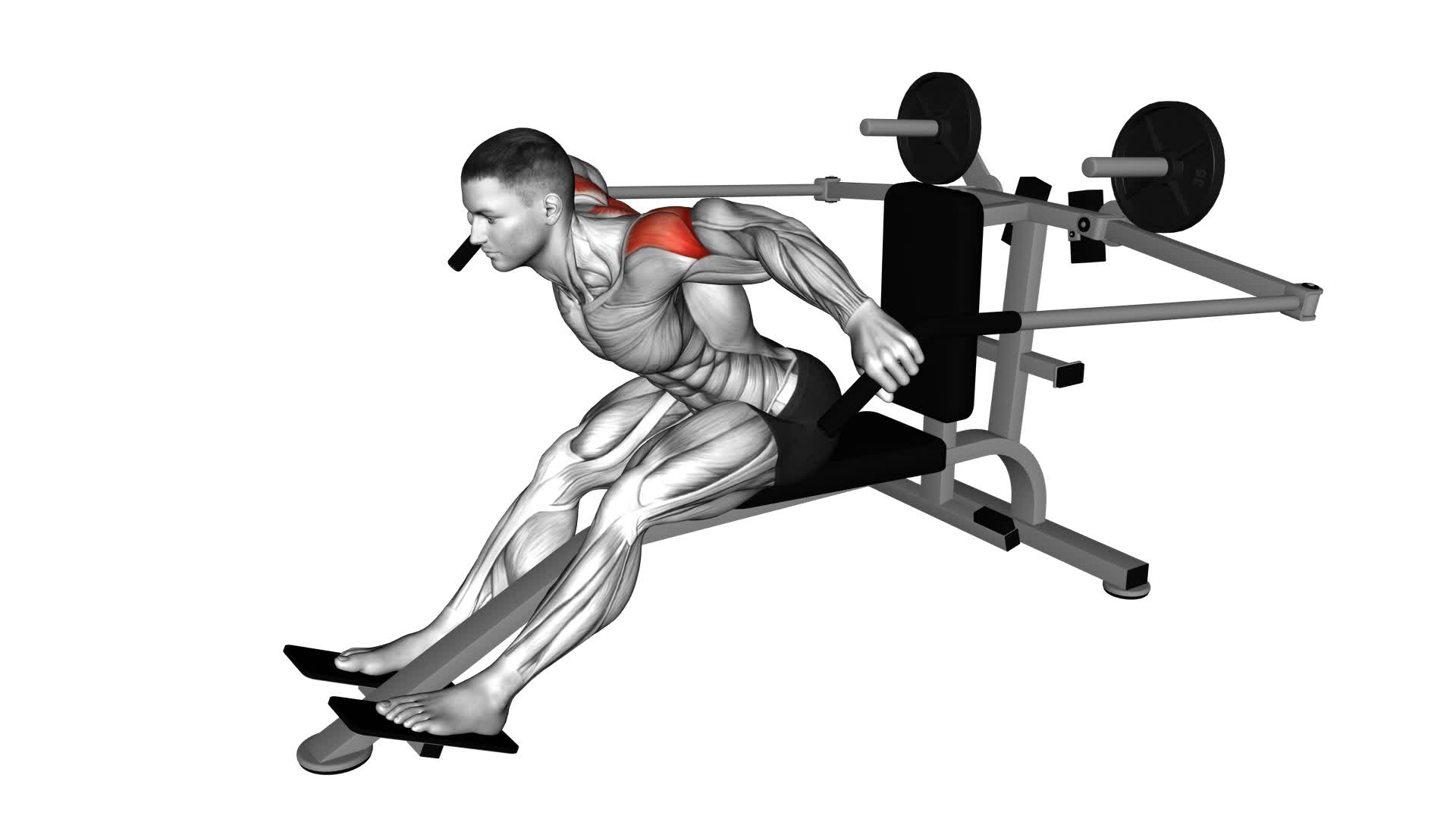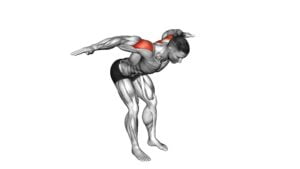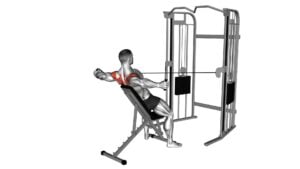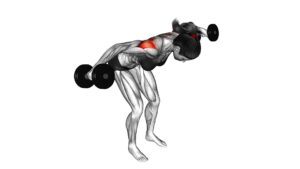Lever Seated Bent Over Rear Delt Fly – Video Exercise Guide & Tips

Looking to target your rear deltoids? Check out this video exercise guide for the lever seated bent over rear delt fly.
Watch This Exercise Video
This move is great for building strength and definition in your upper back and shoulders.
You'll learn the proper form and technique, as well as variations and modifications to suit your fitness level.
Avoid common mistakes and maximize your results with these helpful tips.
Get ready to feel the burn and see the gains!
Key Takeaways
- Proper form and technique is crucial for performing the lever seated bent over rear delt fly, including sitting with feet flat on the floor and back against the backrest and engaging the rear deltoid muscles throughout the movement.
- It is important to use a lever machine designed for targeting the rear deltoid muscles, adjust the seat height and lever arms properly, and lean forward from the hips at a 45-degree angle.
- The exercise primarily targets the rear deltoid muscles but also activates the rhomboids and trapezius muscles, improves shoulder stability, contributes to the development of the posterior chain, and enhances overall upper body strength and posture.
- Variations and modifications of the exercise, such as standing rear delt fly or cable rear delt fly, can be used to add variety, prevent plateaus, and target the rear deltoids from different angles.
Proper Form and Technique
To perform the Lever Seated Bent Over Rear Delt Fly exercise with proper form and technique, follow these steps.
First, sit on the lever machine with your feet flat on the floor and your back straight against the backrest. Grab the handles with an overhand grip, slightly wider than shoulder-width apart.
Next, bend forward at the hips, keeping your back straight and your chest up. This position is important for maintaining shoulder stability during the exercise.
Now, with a slight bend in your elbows, slowly raise the handles out to the sides, squeezing your shoulder blades together. Focus on engaging your rear deltoid muscles throughout the movement. Keep your core engaged and your spine neutral. Avoid using momentum or swinging your body to lift the handles.
The Lever Seated Bent Over Rear Delt Fly exercise is highly beneficial for targeting the rear deltoid muscles, which are often neglected in traditional shoulder exercises. Strengthening these muscles helps improve overall shoulder stability and posture. Additionally, rear delt exercises can help prevent imbalances between the front and back of the shoulders, reducing the risk of shoulder injuries.
With a proper understanding of form and technique, you can effectively reap the benefits of the Lever Seated Bent Over Rear Delt Fly exercise.
Now, let's move on to the equipment and setup required for this exercise.
Equipment and Setup
You will need a lever machine and proper setup to perform the Lever Seated Bent Over Rear Delt Fly exercise effectively. The lever machine is a type of exercise equipment specifically designed to target and strengthen the rear deltoid muscles. It consists of a lever that you can adjust to different positions and resistance levels.
To set up the lever machine for the Lever Seated Bent Over Rear Delt Fly, start by adjusting the seat height so that your feet are firmly planted on the ground. Next, adjust the lever arms so that they're at a comfortable height for your arms to reach. Make sure the lever arms are parallel to the ground.
Once you have set up the machine, sit on the seat with your back straight and your feet flat on the ground. Hold onto the lever handles with an overhand grip. Lean forward from the hips, keeping your back straight, until your torso is at a 45-degree angle.
Maintain this position throughout the exercise to effectively target your rear deltoid muscles. Remember to engage your core and keep your shoulder blades squeezed together for stability. With controlled movements, squeeze your shoulder blades and bring the lever handles back, away from your body, until your arms are parallel to the ground.
Targeted Muscle Group
The Lever Seated Bent Over Rear Delt Fly exercise targets and strengthens the rear deltoid muscles, specifically focusing on the contraction and engagement of the shoulder blades. By performing this exercise, you can effectively activate and strengthen the muscles in your upper back and shoulders.
Here are two key points to understand about the muscle activation and training specificity of the Lever Seated Bent Over Rear Delt Fly:
- Muscle Activation:
- Rear Deltoids: This exercise primarily targets the rear deltoid muscles, which are located at the back of your shoulders. The lever allows for a controlled and isolated movement, ensuring that the rear deltoids are engaged throughout the exercise.
- Rhomboids and Trapezius: In addition to the rear deltoids, the Lever Seated Bent Over Rear Delt Fly also activates the rhomboid and trapezius muscles. These muscles play a crucial role in stabilizing the shoulder blades and supporting proper posture.
- Training Specificity:
- Shoulder Stability: This exercise helps improve shoulder stability by strengthening the muscles responsible for keeping the shoulder joint in its proper position.
- Posterior Chain Development: The Lever Seated Bent Over Rear Delt Fly contributes to the development of your posterior chain, which includes the muscles in your upper back. This can enhance overall upper body strength and improve posture.
Variations and Modifications
Now let's explore some alternative exercise options and adjustments for different abilities when it comes to the lever seated bent over rear delt fly. Whether you're looking to switch up your routine or need to modify the exercise to accommodate your fitness level, there are several variations you can try.
These options will allow you to target the rear deltoid muscles effectively and make the exercise work for you.
Alternative Exercise Options
For a more diverse workout, consider incorporating different variations and modifications of the lever seated bent over rear delt fly exercise.
By trying alternative exercise options, you can target your rear deltoids from different angles and challenge your muscles in new ways.
Here are some exercise alternatives and the benefits they offer:
- Standing Rear Delt Fly: This variation allows you to work your rear deltoids while standing, engaging your core for stability and balance.
- Cable Rear Delt Fly: Using a cable machine adds resistance throughout the entire range of motion, helping to strengthen your rear deltoids more effectively.
By incorporating these alternative exercises into your routine, you can prevent plateaus and keep your workouts exciting.
Now let's explore adjustments for different abilities to ensure everyone can benefit from this exercise.
Adjustments for Different Abilities
To continue targeting your rear deltoids from different angles and challenging your muscles in new ways, let's explore adjustments you can make to the lever seated bent over rear delt fly exercise based on different abilities.
If you're a beginner, you can start by using lighter weights or resistance bands to reduce the intensity of the exercise. This will allow you to focus on proper form and gradually build strength.
Additionally, you can perform the exercise while seated on a stability ball or chair to provide more support and stability.
On the other hand, if you have injuries or limitations, you can modify the exercise by using a towel or resistance band instead of a lever. This will provide less strain on the shoulders while still targeting the rear deltoids effectively.
Remember to always listen to your body and consult with a healthcare professional if needed.
Common Mistakes to Avoid
Avoid these common mistakes when performing the Lever Seated Bent Over Rear Delt Fly exercise to maximize your results:
- Using too much weight: One of the most common mistakes is using weight that's too heavy. This can cause you to sacrifice proper form and put unnecessary strain on your muscles and joints. Start with lighter weights and gradually increase as you become more comfortable with the exercise.
- Rounding your back: Another mistake to avoid is rounding your back during the exercise. This not only reduces the effectiveness of the movement but also puts stress on your lower back. Keep your back straight and engage your core muscles to maintain proper form.
- Lifting your shoulders: Many people tend to lift their shoulders up towards their ears when performing the Lever Seated Bent Over Rear Delt Fly. This takes the focus away from the rear deltoids and places it on the upper traps. Instead, keep your shoulders down and relaxed throughout the movement.
- Swinging the weights: To maximize the benefits of this exercise, it's important to control the movement and avoid swinging the weights. Swinging momentum reduces the workload on your muscles and can lead to injury. Focus on slow and controlled repetitions for optimal results.
Tips for Maximizing Results
To maximize your results with the lever seated bent over rear delt fly, proper form is crucial. Make sure to maintain a slight bend in your knees and keep your back straight throughout the exercise.
Additionally, vary the weight and resistance to challenge your muscles and promote progress.
Lastly, consistency is key for achieving the best results, so aim to perform this exercise regularly as part of your workout routine.
Proper Form Importance
Maximize your results by focusing on proper form during the Lever Seated Bent Over Rear Delt Fly exercise. Paying attention to your form not only helps prevent injuries but also ensures that you target the correct muscles and get the most out of your workout.
Here are some key benefits of maintaining proper form:
- Reduced risk of injury: Proper form helps maintain proper alignment and reduces the strain on your muscles and joints, minimizing the risk of injury.
- Increased muscle activation: By performing the exercise with correct form, you engage the targeted muscles more effectively, leading to better muscle activation and development.
To maintain proper form during the Lever Seated Bent Over Rear Delt Fly, follow these techniques:
- Keep your back straight and core engaged to maintain stability.
- Squeeze your shoulder blades together as you lift the lever, focusing on your rear delts.
- Control the movement and avoid using momentum or swinging your body.
Variation for Progress
To maximize your results and continue progressing, try incorporating different variations of the Lever Seated Bent Over Rear Delt Fly exercise.
By adding variation to your workouts, you can target different areas of your rear delts and challenge your muscles in new ways.
One variation you can try is using different grip positions, such as a wide grip or a narrow grip, to engage different muscle fibers.
Another variation is adjusting the weight or resistance you use, gradually increasing it as you get stronger to continue challenging your muscles.
You can also experiment with different tempos, focusing on slow and controlled movements to really feel the burn.
Consistency for Best Results
To achieve the best results and maximize your progress, it's important to maintain consistency in your Lever Seated Bent Over Rear Delt Fly exercise routine. Consistency is key when it comes to building muscle and improving your training intensity. Here are some tips to help you stay consistent and get the most out of your workouts:
- Set a schedule: Plan your workouts in advance and stick to a regular routine. This will help you stay on track and ensure that you don't miss any sessions.
- Track your progress: Keep a record of your workouts, including the weights used and the number of reps performed. This will allow you to track your progress over time and make adjustments as needed.
- Adjust the intensity: As you get stronger, gradually increase the weight or the number of sets and reps to challenge your muscles and continue making progress.
- Listen to your body: Pay attention to how your body feels during and after each workout. If you need to take a rest day or modify your routine, don't be afraid to do so. It's important to listen to your body and avoid overtraining.
Frequently Asked Questions
How Many Sets and Reps Should I Do for the Lever Seated Bent Over Rear Delt Fly Exercise?
For the lever seated bent over rear delt fly exercise, you should do multiple sets and reps to get the best results. The number of sets and reps will depend on your fitness level and goals.
As a beginner, start with 2-3 sets of 10-12 reps. This will help you build strength and improve your posture.
Incorporating this exercise into your routine can benefit your upper back and shoulder muscles, helping you achieve a balanced physique.
Can I Do This Exercise if I Have a Shoulder Injury?
If you have a shoulder injury, it's important to be cautious when doing exercises that may aggravate it.
Always consult with a medical professional before attempting any exercises for shoulder injuries.
There may be modifications available for the lever seated bent over rear delt fly exercise that can help accommodate your injury and prevent further damage.
Remember to prioritize your safety and listen to your body while exercising.
Is It Necessary to Use a Lever Machine for This Exercise, or Can I Use Dumbbells Instead?
Yes, you can use dumbbells instead of a lever machine for this exercise. However, using a lever machine offers certain benefits.
It provides stability and support, allowing you to focus on targeting your rear deltoids effectively. Additionally, the lever machine offers an adjustable range of motion, allowing you to customize the exercise to your needs.
Nonetheless, if you don't have access to a lever machine, dumbbells can still be a viable alternative for this exercise.
Can I Incorporate This Exercise Into My Full-Body Workout Routine, or Is It Better to Focus on a Specific Muscle Group?
Incorporating this exercise into your full-body workout routine can be beneficial. It targets your rear deltoids, which helps improve overall shoulder strength and stability.
However, it's also important to focus on specific muscle groups to ensure balanced development. By including this exercise, you can work on your shoulder muscles while still addressing other areas of your body.
Remember to listen to your body and adjust your routine accordingly for optimal results.
Are There Any Recommended Warm-Up Exercises or Stretches to Do Before Performing the Lever Seated Bent Over Rear Delt Fly?
Before performing the lever seated bent over rear delt fly, it's important to warm up your muscles and stretch properly. There are recommended warm up exercises and stretches that you can do to prepare your body for this exercise.
These will help increase blood flow to the targeted muscles and improve flexibility, reducing the risk of injury. Incorporating these warm up exercises and stretches into your routine will ensure that you get the most out of your workout.
Conclusion
To conclude, the lever seated bent over rear delt fly is an effective exercise for targeting the rear delts.
By maintaining proper form and technique, using the right equipment and setup, and avoiding common mistakes, you can maximize your results.
Remember to vary the exercise and modify it to suit your fitness level.
With consistency and dedication, you'll see improvements in your rear delt muscles and overall upper body strength.

Author
Years ago, the spark of my life’s passion ignited in my mind the moment I stepped into the local gym for the first time. The inaugural bead of perspiration, the initial endeavor, the very first surge of endorphins, and a sense of pride that washed over me post-workout marked the beginning of my deep-seated interest in strength sports, fitness, and sports nutrition. This very curiosity blossomed rapidly into a profound fascination, propelling me to earn a Master’s degree in Physical Education from the Academy of Physical Education in Krakow, followed by a Sports Manager diploma from the Jagiellonian University. My journey of growth led me to gain more specialized qualifications, such as being a certified personal trainer with a focus on sports dietetics, a lifeguard, and an instructor for wellness and corrective gymnastics. Theoretical knowledge paired seamlessly with practical experience, reinforcing my belief that the transformation of individuals under my guidance was also a reflection of my personal growth. This belief holds true even today. Each day, I strive to push the boundaries and explore new realms. These realms gently elevate me to greater heights. The unique combination of passion for my field and the continuous quest for growth fuels my drive to break new ground.



